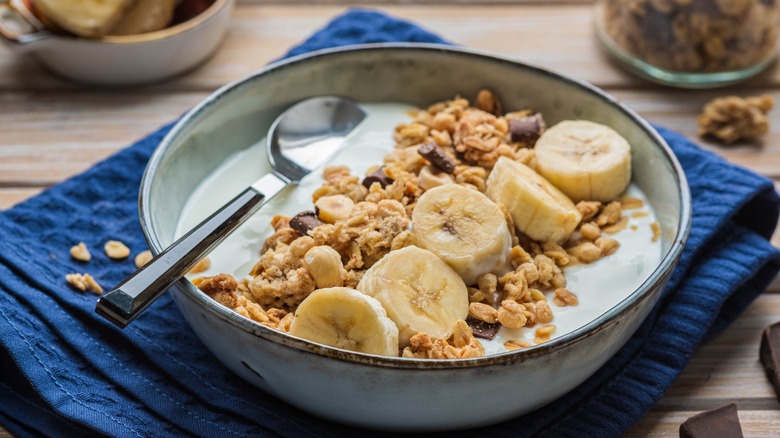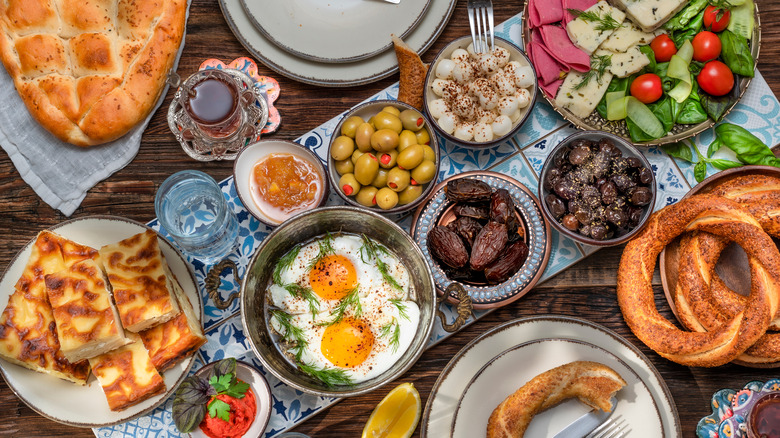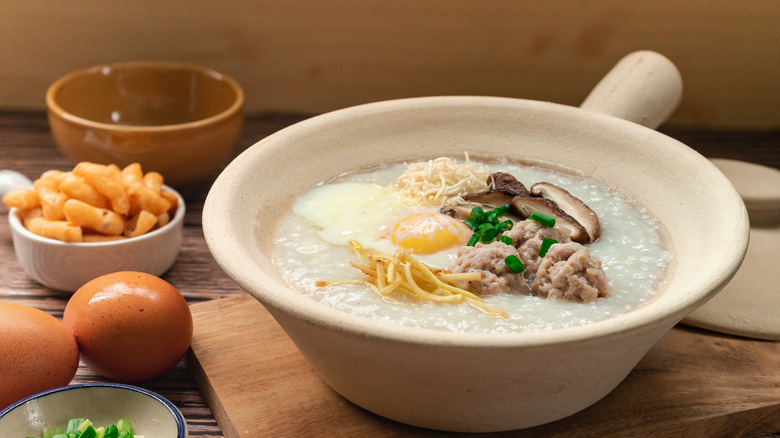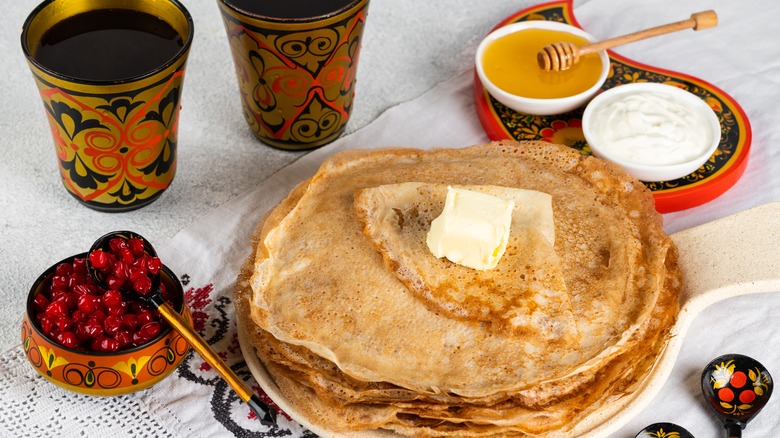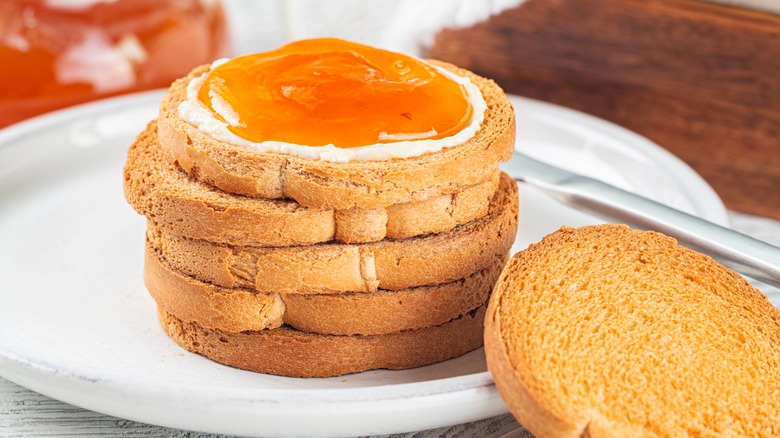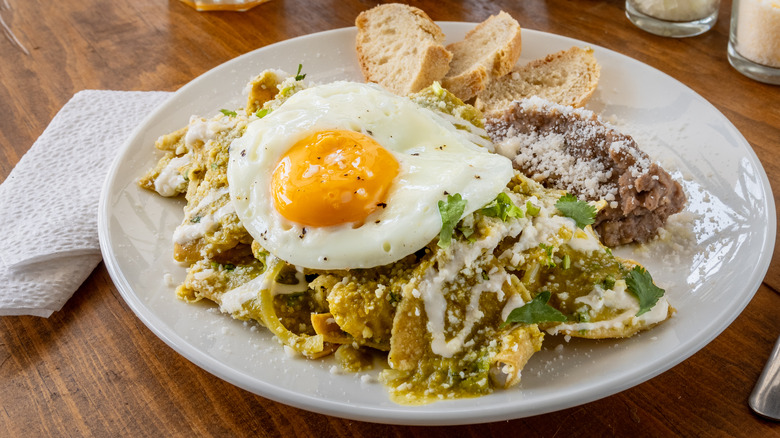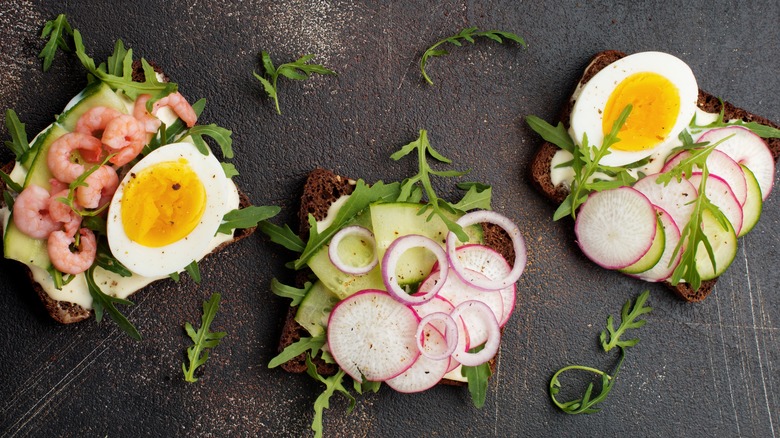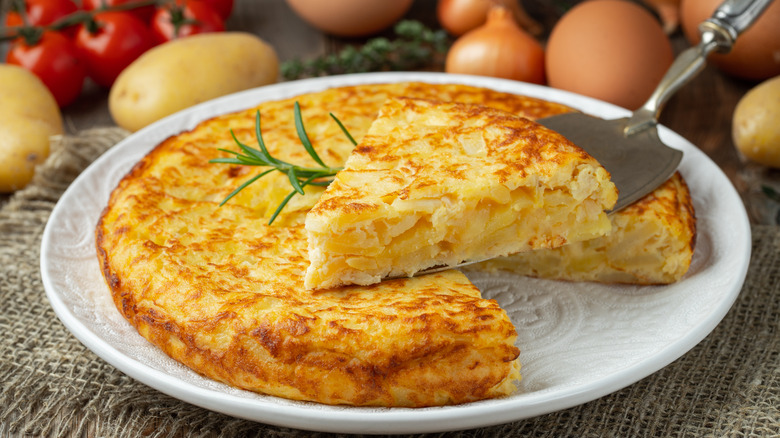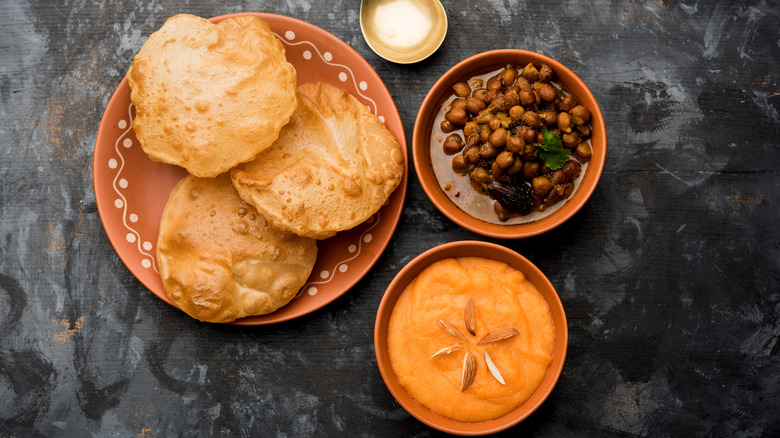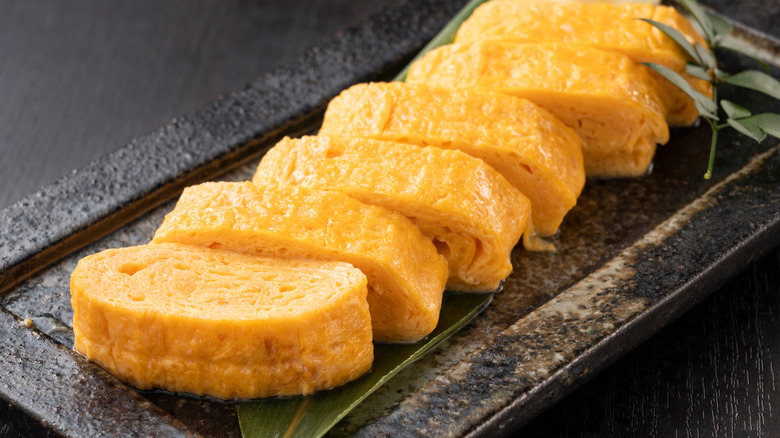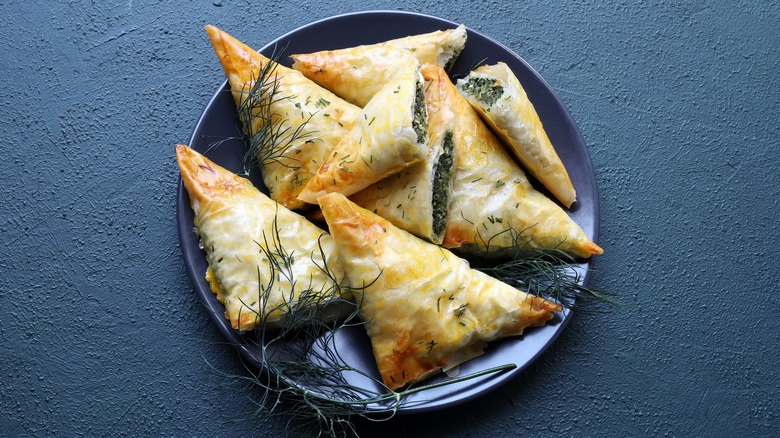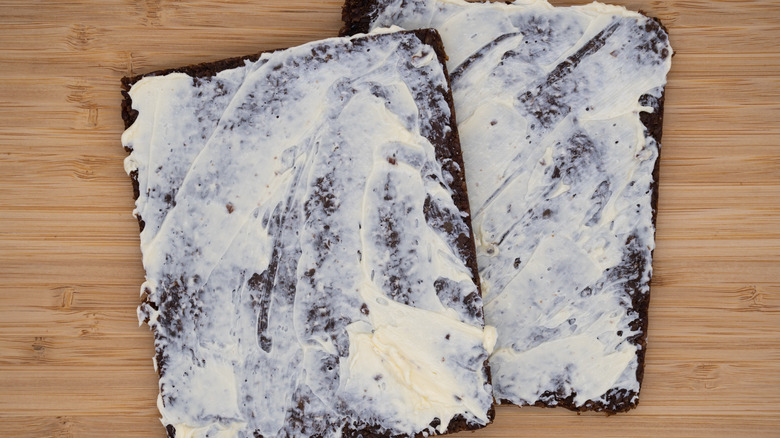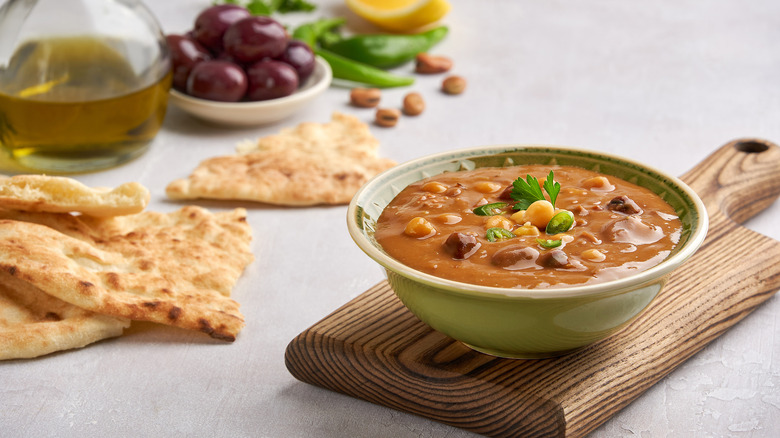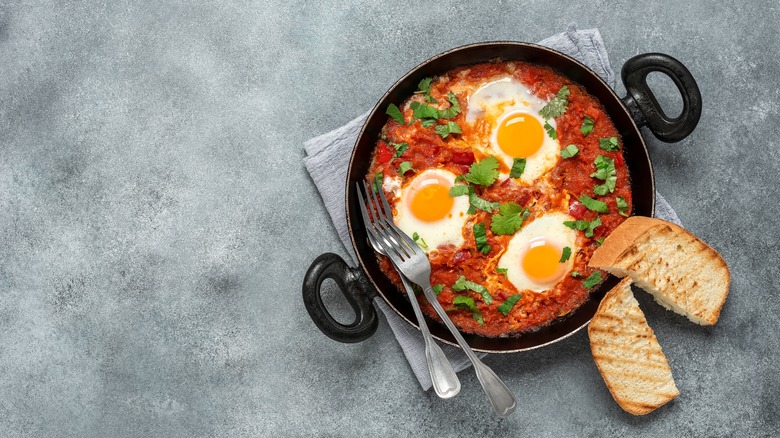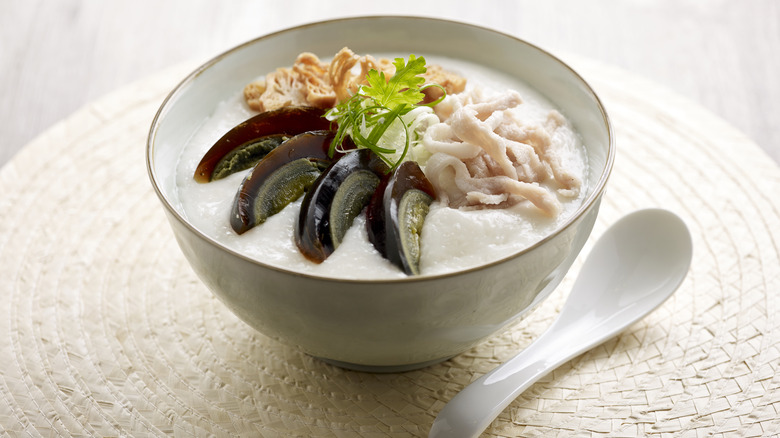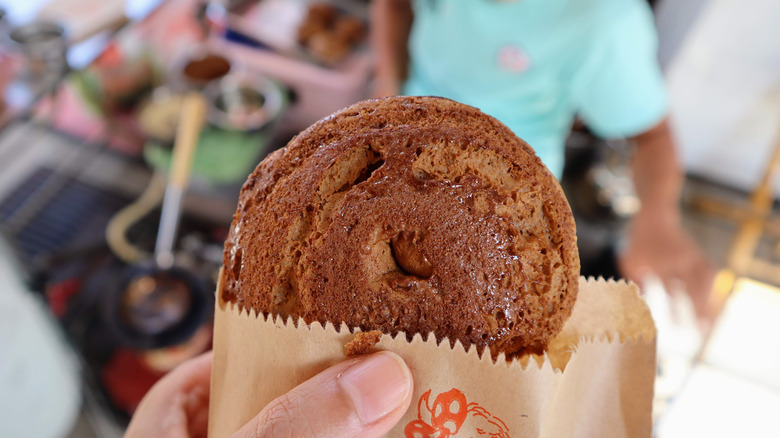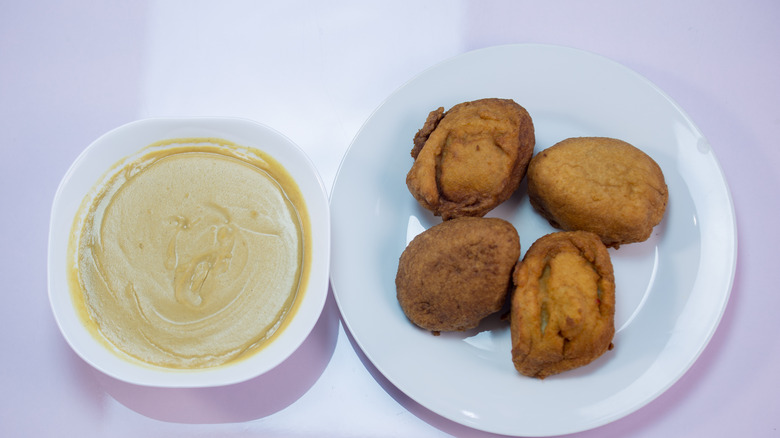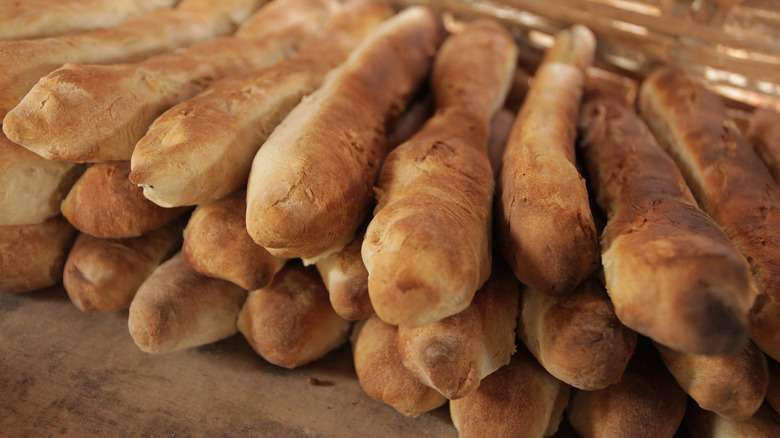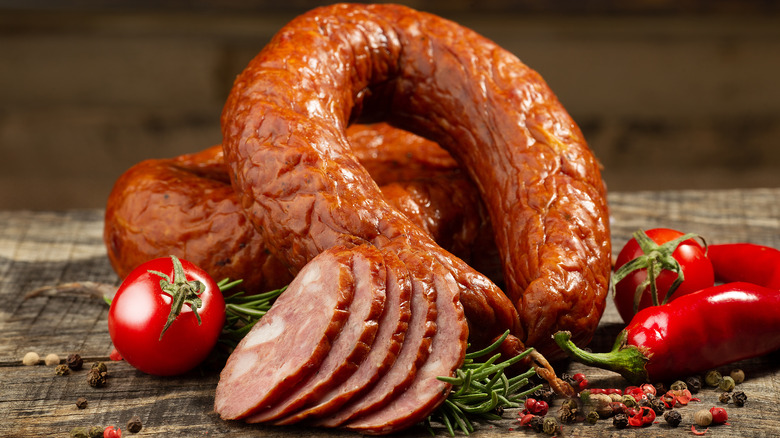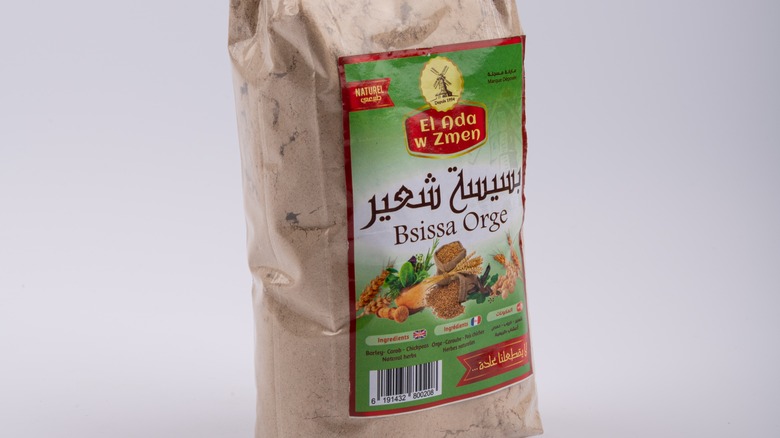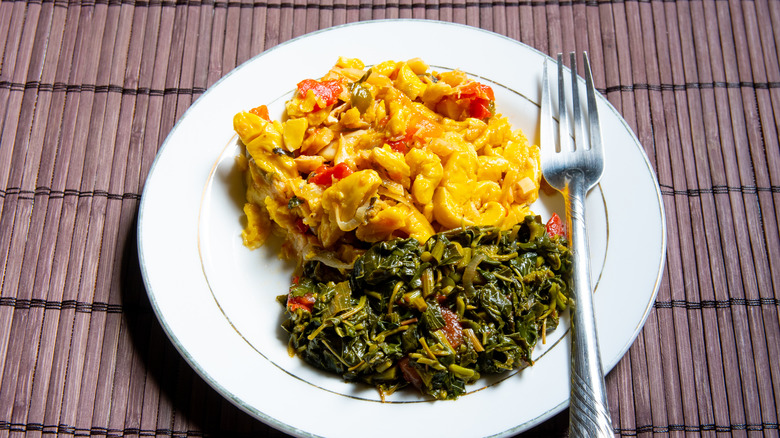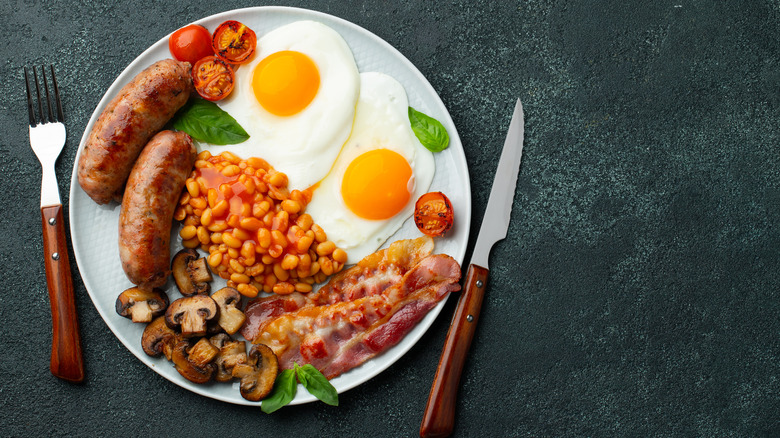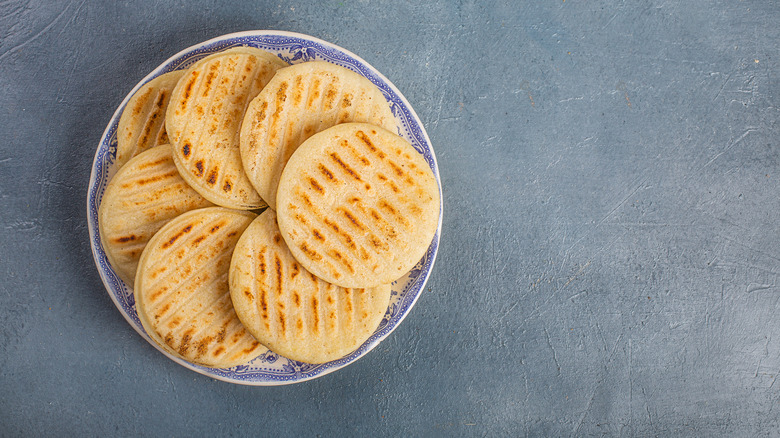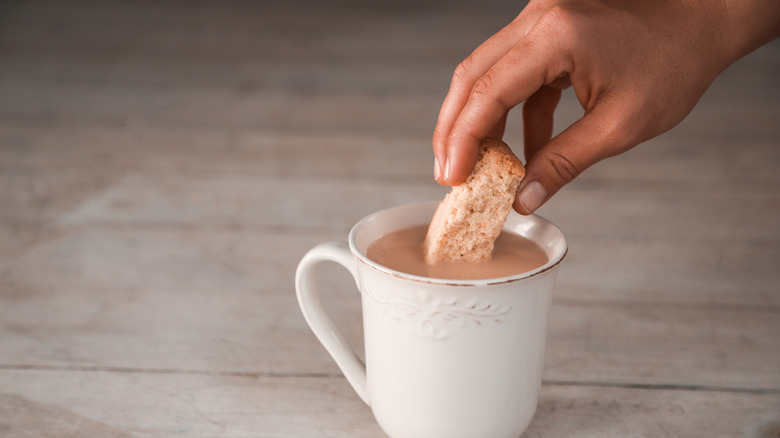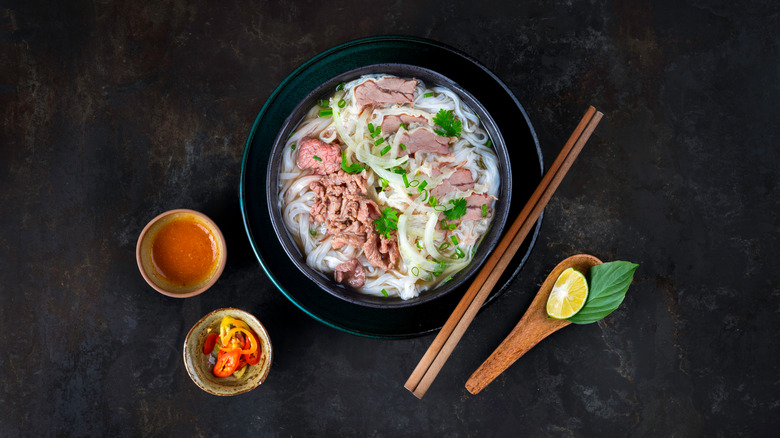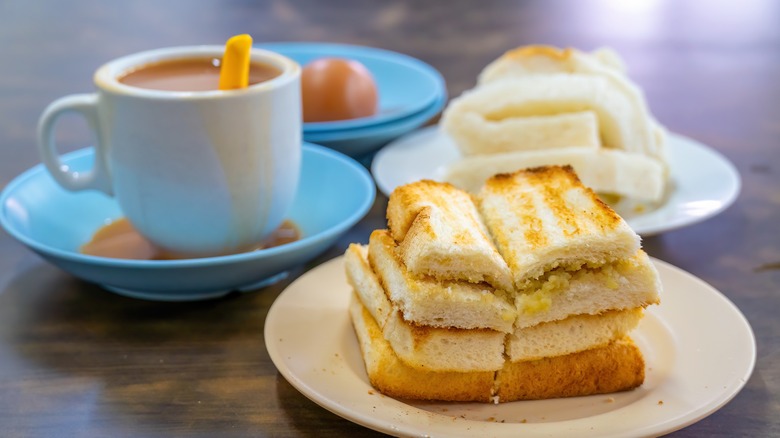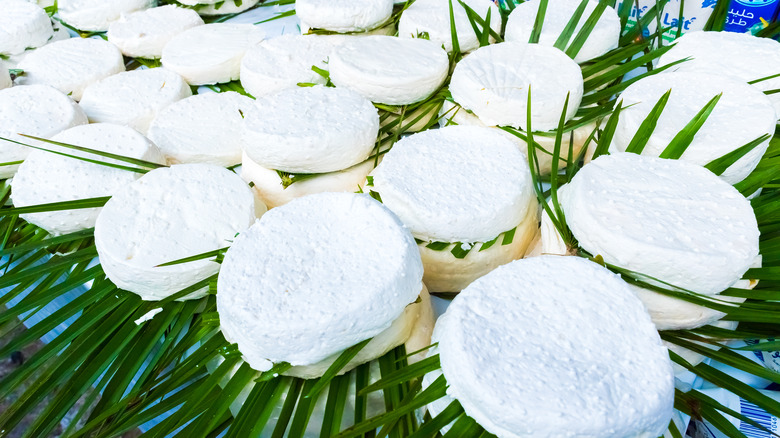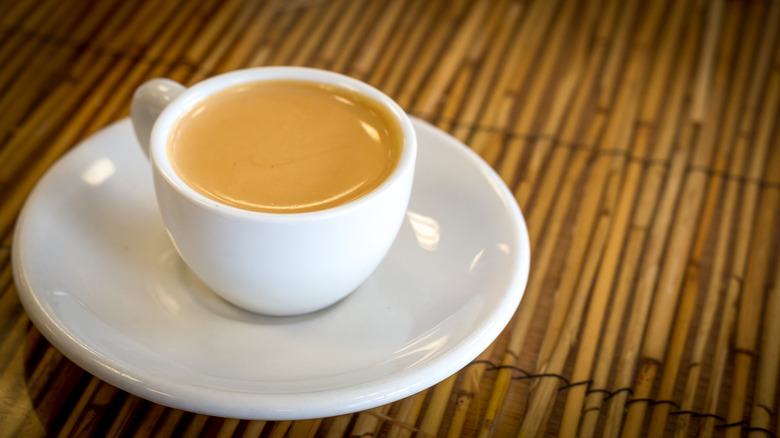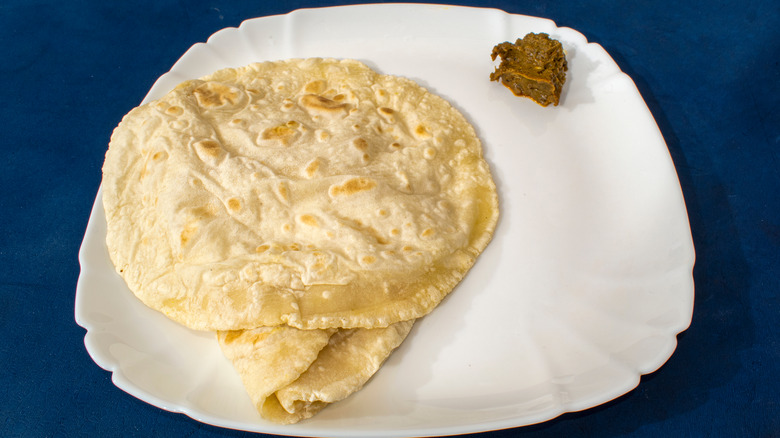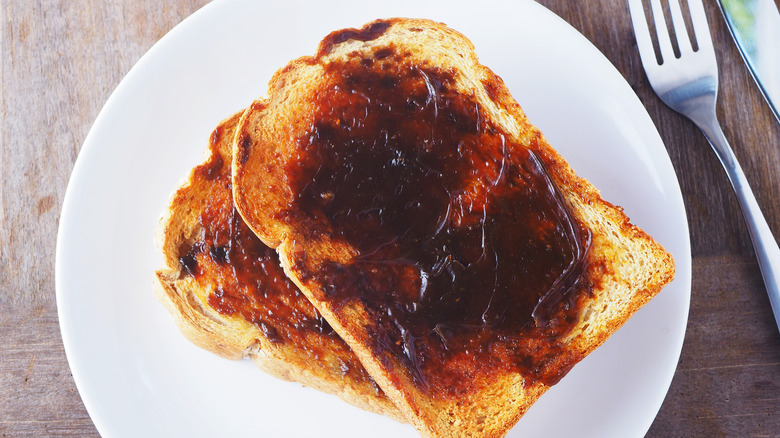What Breakfast Looks Like In 30 Countries Around The World
You've probably heard that breakfast is the most important meal of the day. But why did we start eating this meal in the first place? It is believed that breakfast was shunned by the church; theologian Thomas Aquinas thought that eating too early in the morning was a sin, especially if the population ate before morning mass (via The Atlantic). And since fasting was born out of religious observation, breakfast would mean "breaking the fast." The Tudors were likely the first population to eat breakfast out of necessity, per History Extra, with the movement of workers into urban centers for work. Eating a hearty breakfast before leaving for work would extend the capability of workers to perform long shifts without breaks for eating. So we can say breakfast might have been one of the only good things to come out of capitalism.
Breakfast is a meal that is adapted to the ingredient availability and culinary preferences of countries around the world. While some countries treat breakfast as a special meal with exclusive foods, other cultures don't distinguish breakfast foods from lunch or dinner staples. Here are some of the ways breakfast is eaten in different countries around the world.
France
The French are about all things butter, so it isn't surprising to see that butter is an important ingredient in French breakfasts. The French commonly incorporate both sweet and savory ingredients into their breakfasts. There are a lot of bread dishes and pastries on the French plate, including Pain Perdu, or what Americans think of as French toast, and tartine, which is usually a French bread (like a baguette) toasted and topped with honey, jam, or cheese. Popular French breakfast pastries include the classic croissant, made with laminated dough.
French savory breakfast foods are typically not made with greasy or oily meats, but rather stick to savory and simple egg dishes. Egg and veggie quiches, soft-cooked French omelets with freshly chopped herbs, and croque madames are common savory breakfast foods. The French typically stick to simple breakfasts completed with a hot cup of tea or coffee.
Turkey
Breakfast is a celebrated meal in Turkey and is referred to as "kahvalti." Kahvalti is characterized by a lot of small, bite-sized foods served alongside freshly brewed black tea. Some common kahvalti foods include black and green olives, chopped cucumber, cured meats, cheeses, honey, preserves, and sweet butter with freshly baked bread. As far as the eggs go, sucuklu yumurta is a common Turkish egg dish made with eggs and sausage. A vegetarian scrambled egg dish called menemen may also make an appearance.
Thailand
If you travel to Thailand, you are unlikely to find traditional Western breakfast ingredients like greasy sausage, toast, or bagels. Thai breakfast is called "aahan chow," which roughly translates to "morning food." Thai breakfast dishes are made with many of the same ingredients found in meals later on in the day, but the primary difference between the breakfast food at these other ingredients is a lesser degree of spice.
Khao tom is one of the most popular breakfast foods in Thailand. The dish is made with boiled rice and egg and resembles the texture of extra-thin oatmeal or porridge. The bowl is customized with the addition of protein like pork, poached egg, squid, or octopus and sauces like fish sauce and crushed red pepper.
Russia
Russia was originally a tea-drinking country, but Understand Russia notes that coffee with sugar and cream has become a more common breakfast pairing in recent years. Russian folks short on time will usually make a quick breakfast sandwich with a slice or two of bread, butter, cheese, and a slice of sausage. You'll rarely find scrambled eggs in Russia; most eggs are made either sunny-side up or over-easy.
When time allows, you'll find many Russian homes resort to making more intricate breakfasts like syrniki — cottage cheese stuffed dumplings served with jam or sour cream. Thin Russian blinis (pancakes) are served with fruit preserves, sweetened condensed milk, honey, and sour cream. Some families will also make savory pancakes filled with cabbage, meat, or cottage cheese ahead of time to serve for breakfast (via Understand Russia).
Italy
Mama Loves Italy notes a clear difference between the breakfast eaten in Italian households and the breakfast served in hospitality settings. Italian households tend to stick with simple breakfasts made with uncooked ingredients. The most popular breakfast food in Italy is pane, burro e marmellata — bread, butter, and jam. One particular variation on this Italian breakfast is fette biscottate, a twice-baked thinly sliced bread often served with butter and apricot jam.
Italian cafes usually serve pastries alongside delicious Italian coffee. Some of the more common offerings at cafes include cornetto, an Italian croissant filled with chocolate, jam, or custard, and Italian donuts called ciambella.
Mexico
The hallmark of Mexican cuisine is spice, so it's not surprising that some of the best Mexican seasonings can be found in its breakfast food too. According to Trip Savvy, eating breakfast is especially important in Mexico because the next meal isn't eaten until the later afternoon. Mexican breakfast typically comes in two forms: desayuno, a light meal eaten shortly after waking up, and almuerzo, a mid-day meal that Americans think of more as brunch.
A full Mexican breakfast starts with pan dulce (sweet bread), coffee, and fruit or fruit juice. The main meal is usually eggs of some kind served with Mexican staple ingredients like tortillas, chili peppers, and warm spices. Chilaquile are a popular breakfast dish in both Mexico and American border towns made with corn tortillas smothered in a spicy green or red sauce sprinkled with cojita cheese, crema, and fresh herbs. Typically chilaquiles are served with a diner's choice of eggs or meat for a boost of protein.
Sweden
You may be surprised to know that pickled and preserved fish don't appear on Swedish breakfast tables. Instead, the Swedes focus their breakfast on the quintessential European open-faced sandwiches (smörgås) made with plain or crisp bread (knäckebröd), boiled eggs, fresh veggies, and spreads. Swedes add a salty, tubed cod roe spread to their smörgås or just on top of boiled eggs.
The Swedes are also big fans of eating grains for breakfast and frequently consume cereals or muesli with filmjölk — a milk with a consistency similar to that of buttermilk or cultured kefir. Cooking the Globe notes that Sweden is one of the top five coffee-drinking countries globally, so your Swedish breakfast wouldn't be complete without a warm cup.
Spain
A proper Spanish breakfast is incomplete without coffee and a Spanish tostada — a toasted slice of baguette served with olive oil, grated tomatoes, and sea salt. These sandwiches characteristically do not contain any sauces to better highlight the natural ingredients. Another popular tapas and breakfast item is the tortilla de patatas — the Spanish omelet. This uniquely Spanish dish is made with a base of potatoes, onions, and spices with eggs. Some preparations will include additional ingredients like chorizo or bell peppers. Although the Spanish focus a lot of their breakfast energy on savory items, churros con chocolate can be found in churrerias around Spain.
Pakistan
I Knead to Eat notes the Pakistani breakfast is served as a platter called halwa puri. There are several major elements that make up this platter, starting with poori (puri): a deep-fried soft flatbread made with whole wheat or all-purpose flour. The poori is served with suji (semolina): a sweet cooked pudding made with ghee and sugar. The halwa puri is also served with chana masala, a spicy chickpea curry and aloo ki tarkari, a potato-based curry.
Pakistani breakfasts can also include single-ingredient plates like nehari — cooked beef or lamb shanks in a spicy gravy. Dahi Bhalla is an Indian breakfast dish that is often served for breakfast in Pakistan. This dish is comprised of small lentil dumplings deep-fried and soaked in a yogurt sauce. The Dhalla Bhalla gets its flavor from a blend of fragrant grated ginger, cumin, and coriander.
Japan
Breakfast in Japan follows the format of lunches and dinners. Each meal starts with staples like rice, miso soup, and ohitashi (boiled vegetables) alongside flavorful ingredients like natto (fermented soybeans), pickles, and grilled fish. You may also find tamagoyaki served for breakfast and lunch in Japan; this rolled egg omelet is cooked on a griddle called a tamagoyaki-ki and seasoned with dashi, mirin, and salty Asian seasonings and sliced into bite-sized pieces.
Greece
Like other European countries, Greek breakfasts are centered around good bread, like Greek Koulouri, and lightly sweetened accompaniments. Many Greeks keep breakfast light with a bowl of yogurt drizzled with fresh honey. For a savory breakfast, some families turn to traditional Greek pies like spanakopita: A spinach-filled, phyllo-wrapped pastry served with crumbled feta and seasoned with fresh herbs. Many Greek breakfasts include coffee and spoon sweets — teaspoon-sized sweetened fruit preserves made with ingredients like strawberry, fig, or rose petal.
Germany
Germans focus a lot of their breakfast choices on bread. Of the countless types of bread popular in Germany, breakfast staples often include bread rolls (brötchen) usually made from rye served with marmalades and fruit preserves, butter or margarine, and meats and cheeses. Boiled eggs are often served as an accompaniment along with drinks like coffee, milk, or tea. In Germany, breakfast is not as social as in other countries; rarely will people at the table talk with their mouths full.
Egypt
A Little Nomad notes the most common breakfast in Egypt is ful (pronounced "fool") — fava beans. These beans are soaked overnight and cooked over low heat to allow the bean to come out of their thick pod. Then, the beans are cooked with oil and salt and served as a side dish or made into a sandwich. Ful is often accompanied by pita bread, eggs, cheese, and another Egyptian breakfast staple called ta'meya. Ta' meya resembles the texture of a falafel but is made with fava beans instead of chickpeas.
Israel
Shakshuka is one of the most easily identifiable Israeli breakfast dishes. This dish is made with tomatoes, fresh herbs, spices like paprika, and poached eggs all cooked in a single pan. It is often common to see small bowls of olives, pita bread, and slightly sweetened granola or muesli. The abundance of produce surrounding Israel often means that Israeli breakfasts are served with small side salads made with tabbouleh, cabbage, olive oil, fruits, and nuts.
China
With a country as large as China, there are naturally a lot of regional variations in Chinese breakfast food. Soy milk, rice congee, and deep-fried dough sticks can be served together as a sweet breakfast. Congee itself can be found across China and is made by cooking rice for long periods of time and seasoned with ingredients like fermented tofu, meat, or eggs. Congee can also be made with sweet red beans, coix seeds, peanuts, and black rice.
Taiwan
Many Taiwanese breakfast dishes are centered around starches. Rice balls (Fantuan) can be stuffed with braised eggs, pickled mustard greens, or pickled radish and are easily portable for breakfast on the go. You'll also find a selection of steamed buns made sweet with the addition of brown sugar or savory when filled with soup. As a side dish, some Taiwanese breakfasts also include milk tea or soy milk (served sweetened or unsweetened).
Nigeria
Per Pretend Chef, the most common breakfast dish in Nigeria is a "bread sandwich" with tea. The bread can be filled with mackerel in tomato sauce (geisha), canned sardines, corned beef, or eggs. Akara and pap is another popular breakfast food sold by street vendors rather than made at the home. Akara is a fried bean fritter served with pap, which is a grain paste made from corn or millet. A gruel is made by adding hot water to the paste and serving the two together as a filling meal.
Senegal
Senegalese people often make a millet porridge called lakh for breakfast. The lakh is traditionally served with sweetened fermented milk called lait caillé, but more modern versions of the dish add a bit of sweetened condensed milk instead. Lighter breakfast options include a slice of baguette covered with Nutella or Chocopain — a chocolate and peanut butter spread. Eat Your World suggests the presence of the baguette in Sengalese breakfasts is a node to the French, who occupied the country until the 1960s.
Poland
In Poland, śniadanie (breakfast) is made up of a sandwich with cold cuts, kielbasa, or scrambled eggs served open-faced. There is often a side of dairy, like kefir or quark cheese with radishes. Occasionally, marinated herring will also appear at the Polish breakfast table.
Unlike other countries, many Polish households eat a second breakfast during the mid-day called drugie niadanie which features another sandwich with meats and cheese. Some households drink coffee, tea, or grain-based coffee substitutes (since the drink was in short supply during the communist rule of the country).
Tunisia
Tunisia has many unique breakfast foods. Droo, or crème de sorgho, is made with sorghum grain powder boiled with water and sugar. The pudding is then garnished with peanuts and chamia (sesame seed paste). Other breakfast foods in the country include Bsissa made with cereals, roasted vegetables, and spices. Bsissa can also be made as a powder mixed with olive oil, sugar, or honey. You'll also find thinly pressed semolina flatbread called Mlawi served with ricotta, honey butter, or khcef (quince) jam.
Jamaica
Both sweet and savory dishes can be found served for breakfast in Jamaica. Porridge is a common filling breakfast food made with a base of grated banana or plantain simmered with milk, vanilla, and sweetener until smooth and creamy. Jamaicans also cook their national dish of ackee and saltfish for breakfast. Ackee is a tropical fruit in the same family as the lychee that is cooked with fish (often cod) with scotch bonnet peppers, tomato, garlic, and other peppers.
United Kingdom
There are many similarities between breakfasts in the United Kingdom and the United States. According to the English Breakfast Society, the idea of a full English breakfast dates back to the 1300s when the gentry tried to instill a unifying sense of hospitality amongst their homes and all who visited. The modern full English breakfast includes several staple components like mushrooms, bacon, eggs, sausage, baked beans, and tomatoes. Variations on the dish can include fried bread, black pudding, or "bubble and squeak" — a side made from potatoes and cabbage.
Venezuela
Venezuelan breakfasts wouldn't be complete without arepas. Arepas are regional bread that resembles naan or pita bread. Venezuelan arepas are thicker and smaller than Colombian arepas, but both are made with corn flour, water, and salt. Arepas can be served at any time of day in Venezuela, but the breakfast version is usually stuffed with egg, meat, or avocado. These tiny discs are portable, flavorful, and key to the culinary identity of Venezuela.
South Africa
One of the most simple South African breakfast meals is a museli rusk, a dehydrated biscuit, served with a hot cup of tea. You may also see maize porridge or sorghum served in South African homes; these porridges are nutritionally dense and often customized with ingredients like peanut butter, honey, butter, or milk. If you visit Cape Town, you may find cafes selling sweetened doughnuts flavored with cardamom, aniseed, cinnamon, and coconut — called koesisters.
Vietnam
Pho is a warm soup served for breakfast, lunch, and dinner in Vietnam. Breakfast pho can be flavored with chicken, beef, or vegetables and includes gao te noodles. Some Vietnamese breakfasts are more simple accompaniments like xoi (sticky rice) with ingredients like green beans, peanuts, eggs, or meat. In breakfast stalls in the country, you may also find Trứng Vịt Lộn — boiled duck embryo. This style of egg has much more protein than a standard chicken egg and is favored by many in Vietnam.
Singapore
Because of its location off the Indian subcontinent, many of Singapore's breakfast foods are influenced by both Indian and other familiar South Asian ingredients. Roti prata is a common breakfast food in both India and Singapore; it's a ghee-saturated flatbread often served with fish or mutton curry. You'll also find kaya toast in Singapore. The jam spread (kaya), popular throughout South Asia, is made with coconuts and is commonly served on toast alongside tea and boiled eggs.
Morocco
Moroccan black olives are a staple breakfast ingredient in the country. These salted olives are served on small appetizer plates and within reach of everyone at the table. You'll also find fresh salty Jben cheese served with sweet raw honey. The breakfast is usually tied together with a neutral or savory bread alongside olive oil for dipping. For gatherings of a few guests or family members, Moroccans will serve Moroccan mint tea in a family's special artisan teapot.
Cuba
Cuban breakfast culture is often centered around coffee including café con leche — strong coffee with equal parts scalded milk — or cortadito — two shots of expresso with scalded milk. Common food pairings for Cuban coffee include freshly baked bread served with tropical guava jam or cheeses and fruit. For special occasions, Cuban families may make pan dulce, a sweet dessert roll with a sugary streusel topping similar to (and sometimes interchangeable with) Mexican conchas.
Bangladesh
Breakfasts in Bangladesh focus on a few main staples. Popular starches include a flatbread called ruti, porota (pan-fried flatbread), or fresh rice. These starches are paired with savory breakfast dishes including yellow lentil dal, chicken dopiaza with a rich gravy sauce, and fried eggs. Some families will also combine the starches and proteins together to make dishes like rice biryani. The Hungry Onion notes that some vendors will also serve sobji bazi, spiced green papayas, with the carb-heavy breakfast fare.
Australia
There might not be a more recognizable food in Australia than Vegemite, a savory jarred spread. Vegemite is made with an umami-rich blend of salt, vegetable extract, barley malt extract, and B vitamins. In Australia, Vegemite is commonly spread on toast for a simple, yet savory, breakfast. More elaborate versions of an Australian breakfast can also be found around the country that includes fresh ingredients like corn fritters, avocado salsa, bacon, and eggs. In Sydney, some breakfast cafes serve ricotta hotcakes with honeycomb butter, as well as poached eggs on avocado toast.
